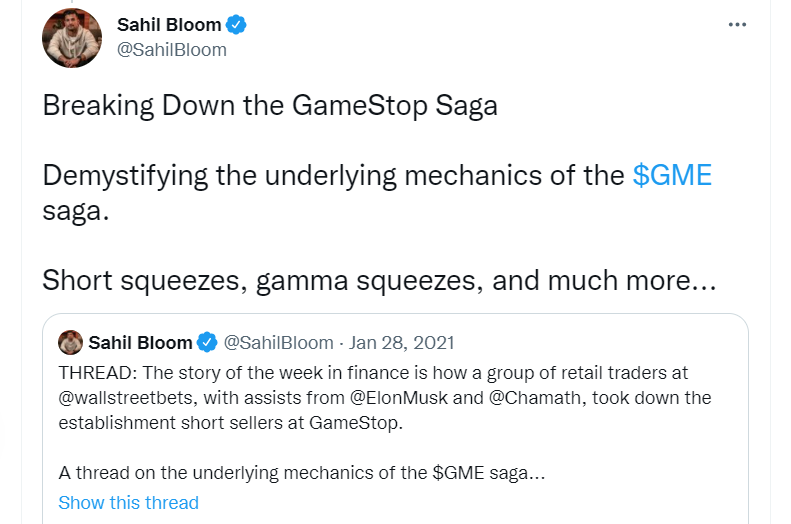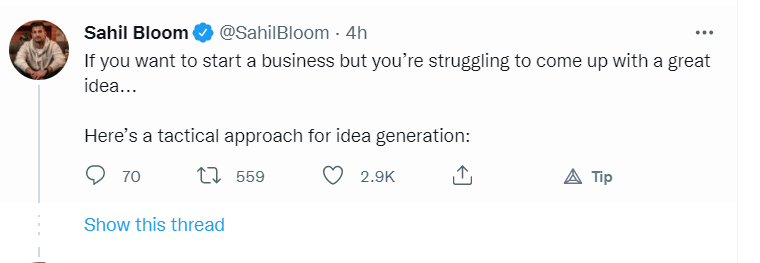Sahil Bloom: From Fund Manager To Twitters Most Followed Finance Guy
“Investor / Educator / StoryTeller”
Sahil Bloom started at Stanford. He went from being a self-described big fish in a small pond to a small fish in a big pond. Once the starting pitcher for the Stanford baseball team. Becoming Twitters go to financial educator a decade later is a curveball.
While at Stanford, Sahil led the Stanford Baseball Team to two regional championships and top-5 rankings and was a two-time winner of the Bruce Cameron Memorial Award, which is awarded annually to a Stanford student-athlete who best exhibits excellence in athletics, academics, and leadership.
But this is where the lines cross, and the Jock becomes the nerd.
After Stanford, Sahil spent seven years at a large investment fund managing >$3.5 billion in capital and serving on the board of 4 companies in the consumer industry, including Fox Racing and Brixton. He’s also privately invested in 30+ companies.
His most interesting resume line to date is his sizeable Twitter & newsletter audience. All in the name of learning about finance.
Joining The Twittersphere
When Covid hit, Sahil didn’t have to spend time on the road making meetings, etc………… which unlocked a bunch of his time. But he couldn’t figure out what to do with it.
After realising, many people were confused about what was happening in finance, business, & markets. And they could only turn to two extremes for advice, like Tiktokers telling people to yolo into random high-risk investments or capital institutions putting out reports full of jargon that no one understood.
He saw an opportunity. Sahil decided to go straight down the middle of those two options and be the ‘Toyota Camry’ of financial insights and say things in a way that anyone can understand.
In May 2020, when he wrote his first thread, he only had 500 followers on Twitter. After some hustle and getting retweeted by the likes of Mark Cuban, he started to blow up. One hundred fifteen threads and 90,000 words later, that audience had grown to 250,000 followers.
Now he’s pushing closer to a million.
Sahil’s a little different to most creators. The way he creates his content, thinks about audience building, and captures value sets him apart.
The following are five big ideas and methods you can learn from Sahil to build your highly engaged and valuable Twitterverse.
Big Ideas
The Community Effect
“The opportunities in my inbox have been unmeasurable.”
Sahil, like many others, believes the network you build at university is more valuable than the education.
This network extends beyond the 10 – 20 close friends you make. Just the mere fact that he studied at the same university at the same time as others has helped him make valuable connections many times over the past decade.
Twitter and other virtual communities provide that same value. You can create and foster meaningful relationships with people you’ve never met in person that can give you access to extraordinary opportunities over time.
For this reason, Sahil always has DM’s open.
The Value Of Writing
“Reading and writing is the key to growth.”
Sahil always enjoyed telling embellished stories but never thought of himself as a writer. Now he translates that storytelling to his writing.
Now he thinks of writing and storytelling as foundational life skills. It helps him think more clearly and exposes the gaps in his thinking.
“Amount that he learned about investing by writing about investing was insane.”
His writing career started with a monthly newsletter he sent to friends and family. He read a lot (4 – 5 books a month) and summarised what he learned in his newsletter.
He’s continued that model on Twitter. Sharing what he’s learning in simple terms as a way to build his understanding of a topic. He feels like a student and learns alongside his audience.
Sahil never thought he’d become a writer or create value from a creative process. His creative writing is what now makes him a unique investor.
Building Audiences Is About Building Trust
“It takes 1000 days to build that trust and 1 day to lose it.”
Sahil often talks about building trust with your audience. It takes a long time to build and is easy to destroy.
There are a couple of ways he builds this trust:
• Create value before you receive it.
• Consistency, keep punching the clock.
• Build authority in a specific domain first
For a long time, Shail only posted a couple of times a week. These were threads on finance-related foundational knowledge.
Audience Produce Massive Serendipity
Writing and building an audience has many positive externalities. It brings Sahil deal flow and introduces him to many interesting people.
Building an audience can give you incredible leverage.
Finance Is Foundational
Sahil believes finance is foundational for life.
People want to be able to take care of their family and friends. Take care of their children and give them a better life than they had. This all comes down to financial wellness.
Define what it is for you, then create a life that matches that definition. Sahil likes to use the fisherman and the investment banker parable to introduce people to this idea.
Actionable Take-aways
The Sahil Bloom Content Flywheel
Sahil publishes 100,000+ words a year, and even more goes unpublished. Here’s the machine behind those words.
First, he sorts his content into two buckets.
1. Education – Mental models, finance, business & decision-making frameworks
2. Stories – Wiki style stories about interesting historical characters or business leaders that people haven’t heard of.
There’s no content calendar.
‘A lot of this is happening in real-time. For example, he wrote a hit thread on Gamestop when that story became part of the news cycle.
But instead of adding to the news cycle by commenting on what is happening. Sahil takes the news and adds value by explaining the why behind the headlines.

The trick here is you already know that people are interested because it’s on the news and talked about on social media.
This generates Sahil ~10 content ideas a day. He captures these ideas as he goes, with Notion. At any given time, he has 100’s of ideas ready to go.
He then tests these ideas by engaging in Twitter comments. For example, if a tweet about network effects goes viral, he will comment ‘time for network effects 101?’. If that gets a lot of likes, he knows that’s a good piece of content.
He follows the same method for people’s ideas. Storing a list of people he thinks will be interesting to write about and are unknown. He knows a thread about Elon Musk would probably blow up, but that’s not interesting to write about.
Those threads become newsletters, and those newsletters become podcasts.
Creating A Twitter Blog
About 15 threads in, he realised he was creating an insightful base of knowledge that he should store in a central repository. So he started a pinned thread that links out to his other threads. It now links to 100+ other threads.

He got this idea from bloggers like Ben Thompson, who inter-link their blogs to create a content ecosystem. Sahil calls this creating content loops.
Writing Threads
Writing threads takes 4 – 8 hours. Depending on the amount of research required.
He follows the Feynman Technique for learning & writing. He’ll write what he knows about a topic, then read/learn/research to fill in the blanks in his knowledge.
If he doesn’t think his take is unique, or he’s getting the point across the right way. He won’t hit publish until satisfied, which benefits from not sticking to a schedule. You give yourself more time to write good content.
He drafts his threads and shares them with a friend before publishing. To make sure there are no apparent gaps in his thinking.
Threads are saturated, so the writing needs to be high quality. The hook needs to be good.

It needs to catch people and draw them in. Wikipedia threads don’t cut the mustard anymore. are no longer valuable and become a bit of a meme
Method #4 Going Viral
You’ve got to spend time on the platform and watch what others are doing to figure out what works and what particular people in that community are looking for.
Sahil spent hundreds of hours testing and learning, figuring out how to write for Twitter. Learning hooks, style, format and so on.
At the start, you have no distribution, so you have to hustle for distribution.
Sahil re-posts his thread as comments on people’s relevant content with large audiences. Sometimes up to 50 times per thread. Each time 2 – 3 people retweet his threads, netting him millions of extra impressions.
Method #5 Capturing Value
Capturing mindshare and attention is a massive asset that you can use to do anything you want. Sahil calls his new wave of influencers the ‘creator capitalist’. Meaning you build audiences to get new opportunities.
Most creators monetise their audience by putting their best content behind a paywall.
Sahil’s a big believer in capturing the value you create, but not by charging for what got you to the dance.
Instead, he partners with brands that are a value-add for his audience. He runs a job board via his newsletter. And takes advantage of the deal flow his audience brings him.
“If you have an audience, it’s a no brainer for startups to bring you on as an investor, especially if the startup is D2c or the product/service it produces is a good fit for your audience.”
Startups are starting to fill out their capital rounds after bringing on a lead investor with ‘creator capitalists’ for brand and product exposure.
However, the pinnacle is building equity in businesses like Mr. Beasts Beast Burgers. Driven by the attention you can generate.
A $10,000 brand sponsorship or $1,000,000 in business equity? Building equity is the big brain play.

